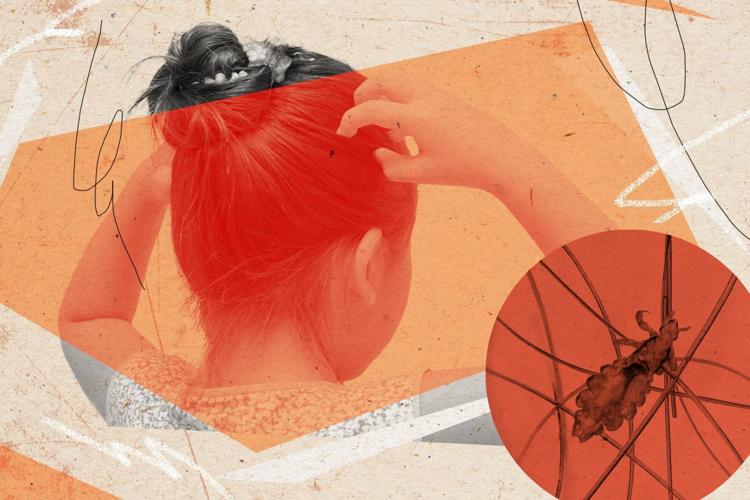Jenny Druery first suspected something was wrong when, in February last year, her six-year-old daughter, “C,” began compulsively scratching her scalp after returning from school.
The 46-year-old Innisfil resident’s worst fears were confirmed when, after combing through C’s hair days later, she noticed little brown dots speckling the teeth of the comb, each about the size of a grain of sand. Druery knew from experience these were “nits,” or lice eggs.
The Star agreed to refer to Druery’s daughter by her first initial for privacy reasons.
Cases requiring treatment have exploded back to pre-pandemic levels, GTA lice-removal services say.
Cases requiring treatment have exploded back to pre-pandemic levels, GTA lice-removal services say.
The mom immediately hit the pharmacy, trying products from Nix to tea tree oil. “We were doing it religiously, and still nothing was working,” she said — even worse, the lice soon spread to her family, first colonizing her mother-in-law’s hair before spreading to her own.
Druery’s family is far from alone. Studies suggest the vast majority of the insects in Canada are now drug-resistant “super lice,” capable of shrugging off most conventional therapeutics.
It’s a symptom of a larger issue. Much like how microbes are developing drug-resistance, insects in general are evolving to overcome pesticides, entomologists say. And it could have grave consequences for the way we control pests and disease vectors in the future.
Lice removal specialists are warning parents to be on guard — with kids mingling at summer camp and back-to-school looming around the corner, they say we’re now in the peak of lice season. Here’s what you need to know.
What are super lice?
Super lice are not new. Head lice have been growing more resistant to drugs for decades now; even in 2010, of lice in Canada were drug resistant. found that, globally, nearly 77 per cent of all head lice carry drug-resistant genes.
And yet, many medical professionals remain unaware.
With schools back in action across the province, it may only be a matter of time before you receive from your child’s teacher a version of the…
With schools back in action across the province, it may only be a matter of time before you receive from your child’s teacher a version of the…
“I’ve been practicing now for over 30 years. When I talk to pharmacists, there still doesn’t seem to be a good awareness of this issue,” said pharmacist Sherry Torkos, who has been working to educate her colleagues on drug-resistant lice. “Medical doctors, a lot them are not even familiar with this.”
The more chemical treatments we use to kill lice, the more opportunities the critters are offered to develop mutations countering the pesticides, she said. These mutations are then passed on to their many, many children — adult females will lay up to 300 eggs over their 30-day life cycle, averaging seven to 10 eggs every day.
Meanwhile, popular lice treatments like Nix, Kwellada and R&C Shampoo were introduced in the 1980s, giving the bugs plenty of time to counter their active ingredients permethrin and pyrethrin.
Unfortunately, many Canadian health agencies still recommend these pharmaceuticals and their derivatives as a first-line treatment, said Jean-Paul Paluzzi, an entomologist and associate professor at York University.
Even if these treatments were able to kill most lice on your scalp, if even a few were drug-resistant, their babies could soon repopulate your hair once the susceptible bugs die out, Paluzzi said.
Lice on the rise
That’s what might have happened to Druery’s family.
After slathering on a cocktail of medications, C’s lice problem appeared to have resolved — for a time. But after C visited her cousin for a sleepover later that summer, Druery received a call she dreaded. The lice were back, and they’d spread from her daughter to her niece.
Deciding enough was enough, all four of the lice-stricken family members paid a visit to lice removal service Lice Squad in Burlington. After a manual removal service and a week of follow-up with enzyme cleaners and other products, Druery says her family is officially lice-free.
“If the typical over-the-counter products were working, we wouldn’t be in business because there wouldn’t be a need for what we do,” said Dawn Mucci, owner of Lice Squad.
From sports and nature to space and food, there are options no matter what your kid may be passionate about.
From sports and nature to space and food, there are options no matter what your kid may be passionate about.
Ever since the end of the pandemic lockdowns, Mucci and other lice specialists have experienced a “huge increase” in demand for their services.
This year is looking especially itchy, added Shawnda Walker, founder of North York-based lice removal service Nitwits. Walker said her business revenues this year are already up 14 per cent compared to 2018, her busiest year pre-COVID.
A significant portion of these came from overnight camps, which Walker said has “one of the highest chances of getting lice.” That’s why her company sees most of its business in July, August and September, when kids return to school.
How to get rid of super lice
Super lice are drug-resistant, but that doesn’t mean all pharmaceuticals are ineffective.
Studies suggest topical treatments like isopropyl myristate, known by its brand name Resultz, are still 52 to 82 per cent effective at killing lice. Because this drug works by dissolving the exoskeleton of the bugs, it’s unlikely for lice to develop drug resistance, Torkos said — although isopropyl myristate is only minimally effective at killing eggs.
Other treatments including dimethicone, brand name NYDA, have shown a more than 97 per cent efficacy in killing lice after nine days of application, and a after eight hours. Because this drug works by cutting off the bugs’ breathing systems, it’s also unlikely for lice to develop resistance to them.
Otherwise, manual lice removal can be effective when done “meticulously,” Torkos said, leading to the popularity of lice removal services. But it’s unlikely to get all the lice — Mucci said her manual sessions tend to remove around 98 per cent of lice and nits, after which clients are recommended to regularly apply cleansing agents.
At the end of the day, remember that you simply showing up for them is what your kids will remember years down the road — not whether they got a
At the end of the day, remember that you simply showing up for them is what your kids will remember years down the road — not whether they got a
It’s better to avoid lice in the first place, said Walker. She advises kids with long hair to keep their locks “nice and tight” in buns and braids at summer camp.
Anecdotally, Walker also finds mint-based products effective at repelling lice: “Lice do not like the smell of mint. It’s a natural repellent to them. So we will often say, get yourself some mint spray and use that — three sprays, twice a day when the kids are at camp.”
The rise of super bugs
For decades, insects have slowly been developing resistance to pesticides, Paluzzi warned.Â
“Pesticide resistance is not something new. It’s been going on for over 75 years now,” he said. “Tons and tons of species, whether they’re agricultural pests, whether they’re disease vectors like mosquitoes and ticks,” are all becoming resistant to common drugs.
It’s a growing problem. to pests in the 1940s; since the 1980s, the number has jumped to around 13 per cent, despite increased usage of pesticides.
So too are genetically modified crops, designed to be poisonous to some insects but harmless to humans, Â as bugs continue to evolve.
That’s not counting the public health risk as disease vectors, like dengue-virus-carrying mosquitoes, .
Named for a greater resistance to some treatments and pesticides that people have used, super
“It is a concern, and it’s part of why the end goal of my own lab’s research is to find new tools, find new targets (for new pesticides),” Paluzzi said. “We have so much resistance to the long-standing compounds that we’ve been using for decades and decades.”
It may only be a matter of time before insects become resistant to the new pesticides. But for now, researchers are doing all they can to stave off the super bugs.


































To join the conversation set a first and last name in your user profile.
Sign in or register for free to join the Conversation